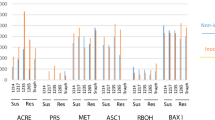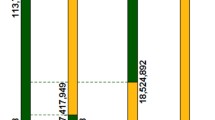Abstract
Alfalfa (Medicago sativa) varieties with antibiosis-based resistance to the root-lesion nematode (Pratylenchus penetrans), a migratory endoparasite of many crops, have been developed by recurrent selection. Individual plants from these varieties that support significantly lower nematode reproduction were identified for molecular and biochemical characterization of defense responses. Before nematode infection, RNA blot analysis revealed 1.3–1.8-fold higher phenylpropanoid pathway mRNA levels in roots of three resistant plants as compared to three susceptible alfalfa plants. The mRNAs encoded the first enzyme in the pathway (phenylalanine ammonia-lyase), the first in the pathway branch for flavonoid biosynthesis (chalcone synthase), a key enzyme in medicarpin biosynthesis (isoflavone reductase) and a key enzyme in the pathway branch for biosynthesis of lignin cell wall precursors (caffeic acid O-methyltransferase). After nematode infection, the mRNAs declined over 48 h in resistant roots but rose in susceptible plants during the first 12 h after-infection and then declined. Acidic β-1,3-glucanase mRNA levels were initially similar in both root types but accumulated more rapidly in resistant than in susceptible roots after nematode infection. Levels of a class I chitinase mRNA were similar in both root types. Histone H3.2 mRNA levels, initially 1.3-fold higher in resistant roots, declined over 6–12 h to levels found in susceptible roots and remained stable in both root types thereafter. Defense-response gene transcripts in roots of nematode-resistant and susceptible alfalfa plants thus differed both constitutively and in inductive responses to nematode infection. HPLC analysis of isoflavonoid-derived metabolites of the phenylpropanoid pathway revealed similar total constitutive levels, but varying relative proportions and types, in roots of the resistant and susceptible plants. Nematode infection had no effect on isoflavonoid levels. Constitutive levels of the phytoalexin medicarpin were highest in roots of the two most resistant plants. Medicarpin inhibited motility of P. penetrans in vitro.
Similar content being viewed by others
References
Barnes DK, Thies JA, Rabas DL, Nelson DL, Smith DM: Registration of two alfalfa germplasms with field resistance to the root lesion nematode. Crop Sci 30: 751–752 (1990).
Basigalup DH: Resistance to Pratylenchus penetrans in alfalfa: mode of inheritance and effects on biological nitrogen fixation. M.S. thesis, Dept. of Agronomy, University of Minnesota (1990).
Bird AF, Bird J: The Structure of Nematodes, 2nd ed., pp. 44–74. Academic Press, San Diego, CA (1991).
Blount JW, Dixon RA, Paiva NL: Stress responses in alfalfa (Medicago sativa L.) XVI. Antifungal activity of medicarpin and its biosynthetic precursors; implications for the genetic manipulation of stress metabolites. Physiol Mol Plant Path 141: 333–349 (1992).
Brosch G, Ransom R, Lechner T, Walton JD, Loidl P: Inhibition of maize deacetylases by HC toxin, the host-selective toxin of Cochliobolus carbonum. Plant Cell 7: 1941–1950 (1995).
Brueske CH: Phenylalanine ammonia lyase activity in tomato roots infected and resistant to the root-knot nematode, Meloidogyne incognita. Physiol Plant Path 16: 409–414 (1980).
Cai, D, Kleine M, Kifle S, Harloff H-J, Sandal NN, Marcker KA, Klein-Lankhorst RM, Salentijn EMJ, Lange W, Stiekma WJ, Wyss U, Grundler FMW, Jung C: Positional cloning of a gene for nematode resistance in sugar beet. Science 275: 832–834 (1997).
Chang LM: The repellent effect of necrotic tissues on the nematode Pratylenchus penetrans (Cobb, 1917), Filipjev and Schurmans Stekhoven, 1941. M.S. thesis, University of Massachusetts (1969).
Chomczynski P, Sacchi N: Single-step method of RNA isolation by acid guanidinium isothyiocyanate-phenol-chloroform extraction. Anal Biochem 162: 156–159 (1987).
Davis KR, Darvill AG, Albersheim P: Several biotic and abiotic elicitors act synergistically in the induction of phytoalexin accumulation in soybean. Plant Mol Biol 6: 23–32 (1986).
Ebel J, Cosio EG: Elicitors of plant defense responses. Int Rev Cytol 148: 1–31 (1994).
Edens RM, Anand SC, Bolla RI: Enzymes of phenylpropanoid pathway in soybean infected with Meloidogyne incognita or Heterodera glycines. J Nematol 27: 292–303 (1995).
Edwards R, Mizen KA, Cook R: Isoflavonoid conjugate accumulation in the roots of lucerne (Medicago sativa) seedlings following infection by the stem nematode (Ditylenchus dispaci). Nematologica 41: 51–66 (1995).
Engler-Blum G, Meier M, Frank J, Muller GA: Reduction of background problems in nonradioactive northern and southern blot analyses enables higher sensitivity than 32P-based hybridizations. Anal Biochem 210: 235–244 (1993).
Forrest JMS, Robertson WM: Characterization and localization of saccharides on the head region of four populations of the potato cyst nematode Globodera rostochiensis and G. pallida. J Nematol 18: 23–26 (1986).
Gamborg OL, Miller RA, Ojima K: Nutritional requirements of suspension cultures of soybean root cells. Exp Cell Res 50: 151–158 (1968).
Goddijn OJM, Lindsey K, van der Lee FM, Klap JC, Sijmons PC: Differential gene expression in nematode-induced feeding structures of transgenic plants harbouring promoter-gusA fusion constructs. Plant J 4: 863–873 (1993).
Gowri G, Paiva NL, Dixon RA: Stress responses in alfalfa (Medicago sativa L.) 12. Sequence analysis of phenylalanine ammonia-lyase (PAL) cDNA clones and appearance of PAL transcripts in elicitor-treated cell cultures and developing plants. Plant Mol Biol 17: 415–429 (1991).
Gowri G, Bugos RC, Campbell WH, Maxwell CA, Dixon RA: Stress responses in alfalfa (Medicago sativa L.) X. Molecular cloning and expression of S-adenosyl-L-Methionine:caffeic acid 3-O-methyltransferase, a key enzyme of lignin biosynthesis. Plant Physiol 97: 7–14 (1991).
Gurr SJ, McPherson MJ, Scollan C, Atkinson HJ, Bowles DJ: Gene expression in nematode-infected plant roots. Mol Gen Genet 226: 361–366 (1991).
Huang JS, Barker KR: Glyceollin I in soybean-cyst nematode interactions. Plant Physiol 96: 1302–1307 (1991).
Joosten MHAJ, de Wit PJGM: Identification of several pathogenesis-related proteins in tomato leaves inoculated with Cladosporium fulvum (syn. Fulvia fulva) as 1,3-_-glucanases and chitinases. Plant Physiol 89: 945–951 (1989).
Junghans H, Dalkin K, Dixon RA: Stress responses in alfalfa (Medicago sativa L.) 15. Characterization and expression patterns of members of a subset of the chalcone synthase multigene family. Plant Mol Biol 22: 239–253 (1993).
Kaplan DT, Keen NT: Mechanisms conferring plant incompatibility to nematodes. Revue Nematol 3: 123–134 (1980).
Kaplan DT, Keen NT, Thomason IJ: Association of glyceollin with the incompatible response of soybean roots to Meloidogyne incognita. Physiol Plant Pathol 16: 309–318 (1980).
Kaplan DT, Keen NT, Thomason IJ: Studies on the mode of action of glyceollin in soybean incompatibility to the root knot nematode, Meloidogyne incognita. Physiol Plant Path 16: 319–325 (1980).
Kapros T, Bogre L, Nemeth K, Bako L, Gyorgyey J, Wu SC, Dudits D: Differential expression of histone H3 variants during cell cycle and somatic embryogenesis. Plant Physiol 98: 621–625 (1991).
Kessmann H, Edwards R, Geno PW, Dixon RA: Stress responses in alfalfa (Medicago sativa L) V. Constitutive and elicitor-induced accumulation of isoflavonoid conjugates in cell suspension cultures. Plant Physiol 94: 227–232 (1990).
Lambert K, Williamson V: cDNA library construction using PCR. Soc Nematol Mol Biol Newsl 4: 10–11 (1992).
Leath KT, Erwin DC, Griffin GD: Diseases and nematodes. In: Hansen AA, Barnes DK, Hill Jr RR (eds) Alfalfa and Alfalfa Improvement. American Society of Agronomy, Madison, WI,. Monograph 29, pp. 621–670 (1988).
Maher EA, Lamb CJ, Dixon RA: Stress responses in alfalfa (Medicago sativa L.) XVII. Identification of multiple hydrolases and molecular characterization of an acidic glucanase. Physiol Mol Plant Path 43: 329–342 (1993).
Mauch F, Mauch-Mani B, Boller T: Antifungal hydrolases in pea tissue II. Inhibition of fungal growth by combinations of chitinase and β-1,3-glucanase. Plant Physiol 88: 936–942 (1988).
Miller KJ, Hadley JA, Gustine FL: Cyclic β–1,6–1,3-glucans of Bradyrhizobium japonicum USDA 110 elicit isoflavonoid production in the soybean (Glycine max) host. Plant Physiol 104: 917–923 (1994).
Mittler R, Lam E: Sacrifice in the face of foes: Pathogeninduced programmed cell death in plants. Trends Microbiol 10: 10–15 (1996).
Munch S: Nonradioactive northern blots in 1.5 days and with substantially increased sensitivity through ‘alkaline blotting’. Biochemica 11: 29–31 (1994).
Niebel A, De Almeida Engler J, Tire C, Engler G, Van Montagu M, Gheysen G: Induction patterns of an extensin gene in tobacco upon nematode infection. Plant Cell 5: 1697–1710 (1993).
Niebel A, Gheysen G, Van Montagu M: Plant-cyst nematode and plant-root-knot nematode interactions. Parasitol Today 10: 424–430 (1994).
O'Neill NR: Defense expression in protected tissues of Medicago sativa is enhanced during compatible interactions with Colletotrichum trifolii. Phytopathology 86: 1045–1050 (1996).
Opperman CH, Taylor CG, Conkling MA: Root-knot nematode-directed expression of a plant root-specific gene. Science 263: 221–223 (1994).
Painter RH: The mechanisms of resistance. In Insect Resistance in Crop Plants, pp. 23–83. MacMillan, New York (1951).
Paiva NL, Edwards R, Sun Y, Hrazdina G, Dixon RA: Stress responses in alfalfa (Medicago sativa L.). 11. Molecular cloning and expression of isoflavone reductase, a key enzyme of isoflavonoid phytoalexin biosynthesis. Plant Mol Biol 17: 653–667 (1991).
Potenza CL, Thomas SH, Higgins EA, Sengupta-Gopalan C: Early root response to Meloidogyne incognita in resistant and susceptible alfalfa cultivars. J Nematol 28: 475–484 (1996).
Rahimi S, Perry RN, Wright DJ: Identification of pathogenesis-related proteins induced in leaves of potato plants infected with potato cyst nematodes, Globodera species. Physiol Mol Plant Path 49: 49–59 (1996).
Rich JR, Keen NT, Thomason: Association of coumestans with the hypersensitivity of lima bean roots to Pratylenchus scribneri. Physiol Plant Path 10: 105–116 (1977).
Sambrook J, Fritsch EF, Maniatis T: Molecular Cloning: A Laboratory Manual, 2nd ed. Cold Spring Harbor Laboratory Press, Plainview, NY (1989).
Sela-Buurlage MB, Ponstein As, Bres-Vloemans SA, Melchers LS, van den Elzen PJM, Cornelissen BJC: Only specific tobacco (Nicotiana tabacum) chitinases and β-1,3-glucanases exhibit antifungal activity. Plant Physiol 101: 857–863 (1993).
Sijmons PC: Plant-nematode interactions. Plant Mol Biol 23: 17–931 (1993).
Smith CJ: Accumulation of phytoalexins: defense mechanism and stimulus response. New Phytol 132: 1–45 (1996).
Spanakis E: Problems related to the interpretation of autoradiographic data on gene expression using common constitutive transcripts as controls. Nucl Acids Res 21: 3809–3819 (1993).
Spiegel Y, Cohn E, Spiegel S: Characterization of sialyl and galactosyl residues on the body wall of different plant parasitic nematodes. J Nematol 14: 33–39 (1982).
Stevenson PC, Turner HC, Haware MP: Phytoalexin accumulation in the roots of chickpea (Cicer arietinum L.) seedlings associated with resistance of fusarium wilt (Fusarium oxysporum f.sp. ciceri). Physiol Mol Plant Path 50: 167–178 (1997).
Thies JA, Basigalup D, Barnes DK: Inheritance of resistance to Pratylenchus penetrans in alfalfa. J Nematol 26: 452–459 (1994).
Thies JA, Petersen AD, Barnes DK: Host suitability of forage grasses and legumes for root-lesion nematode Pratylenchus penetrans. Crop Sci 35: 1647–1651 (1995).
Tiller SA, Parry AD Edwards R: Changes in the accumulation of flavonoid and isoflavonoid conjugates associated with plant age and nodulation in alfalfa (Medicago sativa). Physiol Plant 91: 27–36 (1994).
Townshend JL, Stobbs L, Carter R: Ultrastructural pathology of cells affected by Praylenchus penetrans in alfalfa roots. J Nematol 21: 530–539 (1989).
Townshend JL, Stobbs L: Histopathology and histochemistry of lesions caused by Pratylenchus penetrans in roots of forage legumes. Can J Plant Path 3: 123–186 (1981).
Trudgill DL: Resistance to and tolerance of plant parasitic nematodes. Annu Rev Phytopath 29: 167–192 (1991).
Van der Eycken W, Engler J, Inzé D, Van Montagu M, Gheysen G: A molecular study of root-knot nematode-induced feeding sites. Plant J 9: 45–54 (1996).
Wu SC, Grorgyey J, Dudits D: Polyadenylated H3 histone transcripts and H3 histone variants in alfalfa. Nucl Acids Res 17: 3057–3063 (1989).
Wyss U: Ectoparasitic root nematodes: Feeding behavior and plant cell responses. In: Zuckerman BM, Rohde RA (eds) Plant Parasitic Nematodes, pp. 211–220. Academic Press, New York (1981).
Zacheo G, Bleve-Zacheo T, Lamberti F: Role of peroxide and superoxide dismutase in resistant and susceptible tomato cultivars infested by Meloidogyne incognita. Nematol Mediterr 10: 75–80 (1982).
Zunke, U: Observations on the invasion and endoparasitic behavior of the root lesion nematode Pratylenchus penetrans. J Nematol 22: 309–320 (1990).
Author information
Authors and Affiliations
Rights and permissions
About this article
Cite this article
Baldridge, G.D., O'Neill, N.R. & Samac, D.A. Alfalfa (Medicago sativa L.) resistance to the root-lesion nematode, Pratylenchus penetrans: defense-response gene mRNA and isoflavonoid phytoalexin levels in roots. Plant Mol Biol 38, 999–1010 (1998). https://doi.org/10.1023/A:1006182908528
Issue Date:
DOI: https://doi.org/10.1023/A:1006182908528




